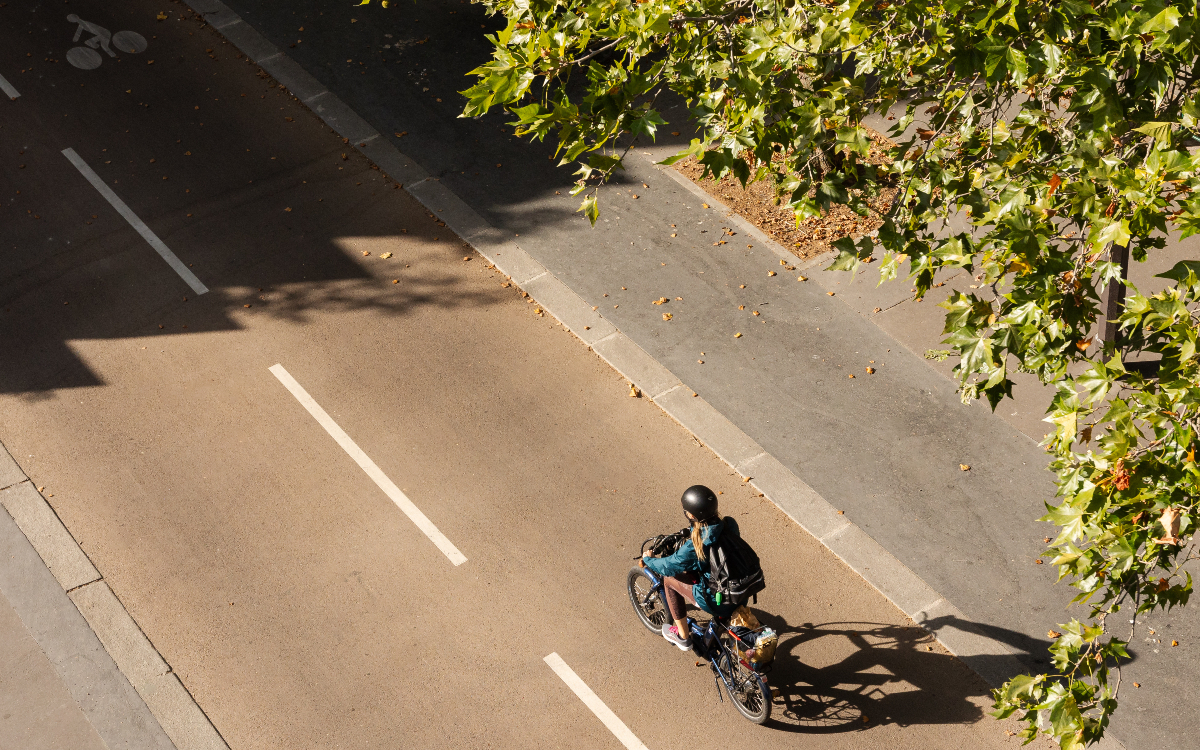Content
Cette page est aussi disponible en français
The 2021-2026 cycling plan is set to transform Paris into a fully cycle-friendly city, with new infrastructure, extensive development of secure parking solutions, and an enhanced cycling ecosystem.
Bicycle Plan, Act 2: Following the initial plan (2015-2020) with a budget of 150 million euros, the new 2021-2026 plan further expands the presence of bicycles in Paris and continues the development of a cycling city that began two decades ago. This represents a budget of over 250 million euros in investments, or 100 million euros more than the previous mandate's cycling plan. Here are the main objectives of the new plan:
Building towards a complete cycle network
By 2021, Paris will have more than 1,000 km of cycling lanes, including over 300 km of lanes and 52 km of temporary lanes built after the initial containment period. These will be fully maintained.
180 km of new secure routes
-
130 km of new trails
-
52 km of "coronapistes" made permanent
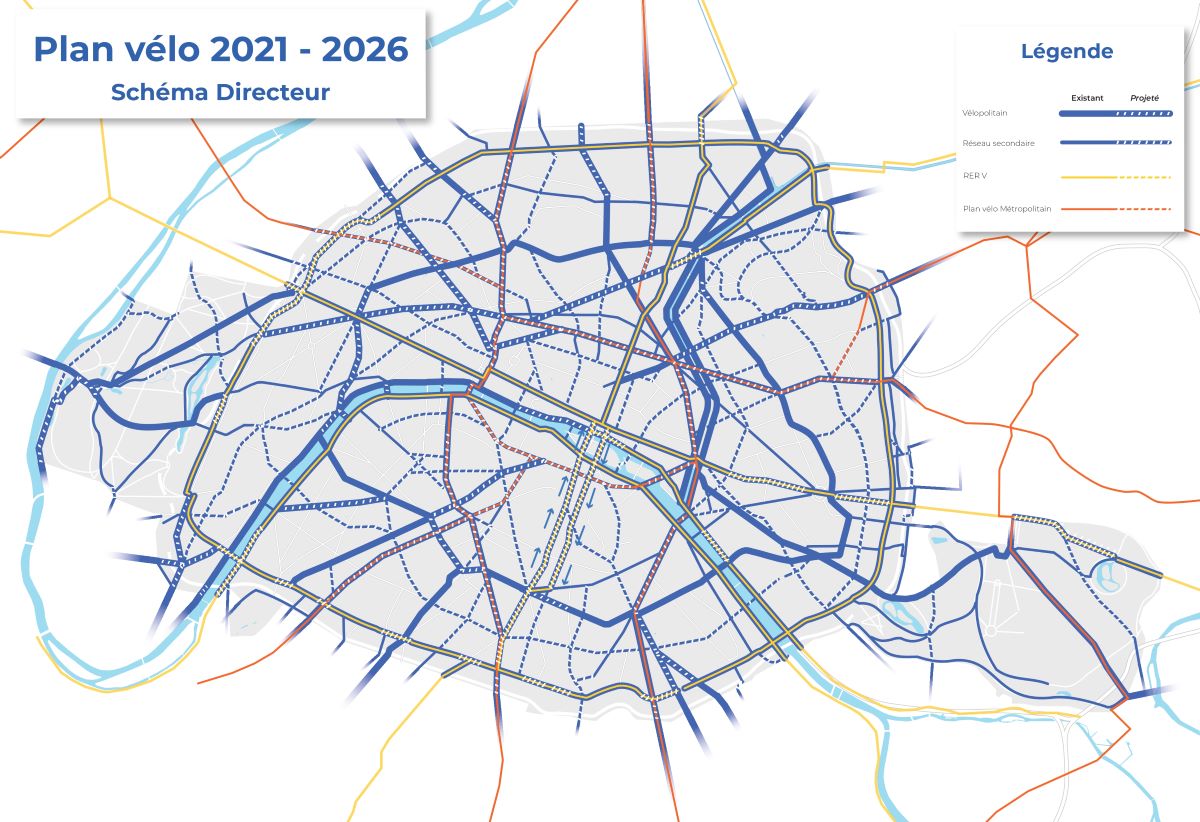
Map of the Bicycle Plan 2021 2026
Crédit photo :
Ville de Paris
The cycling infrastructure in Paris is designed around a network of cycle routes that are being developed at Parisian, metropolitan, and regional levels.
These include :
-
integration of the Île-de-France region's RER-Vélo and the Greater Paris metropolitan area's Vélopolitain, as well as continuity between Parisian bike lanes and bike lanes in neighboring towns.
-
The Parisian Vélopolitain network integrates the regional RER Vélo routes and is part of the Vélopolitain network of the Greater Paris Metropolis, which extends beyond the Paris ring road to cover the entire metropolis.
-
The secondary network is designed to complement the main network by providing a dense network to capture the bulk of bicycle trips over 1 km. This network is particularly useful for inter-arrondissement trips.
-
The aim of the local service network is to enable cyclists to travel on every street in the capital, making it possible to travel by bike from end to end.
Two-way cycling and developing local networks
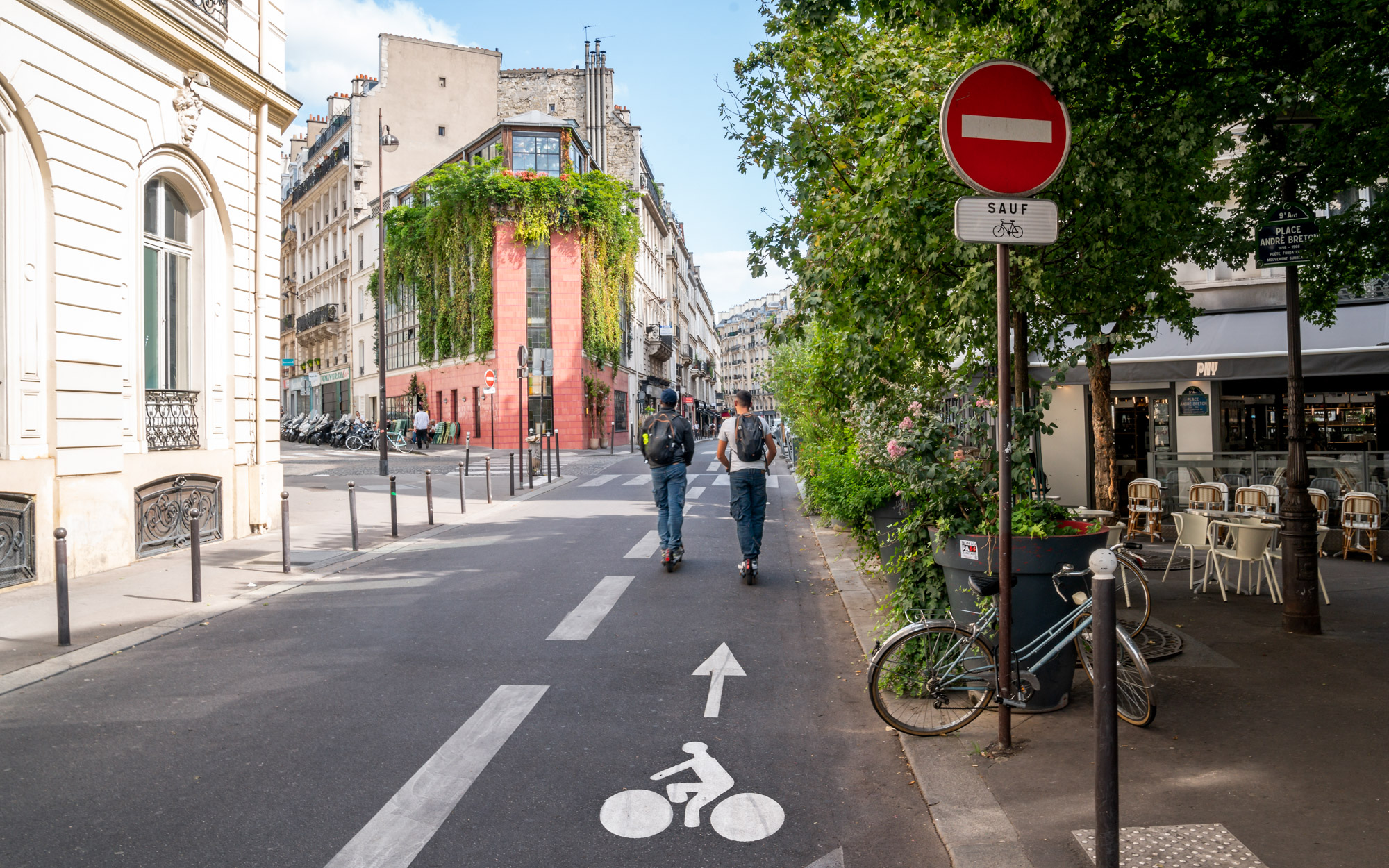
Cycle lane on rue de Douai (9th arrondissement).
Crédit photo :
Clement Dorval / Ville de Paris
Objective: 450 km by the end of the mandate, of which 60 km have already been completed.
The intersection and gateway safety
The aim is to bridge the urban divide between Paris and the metropolitan area.
A concerted approach
Each cycling development project is the subject of a wide-ranging consultation process involving the Préfecture de Police, RATP, Île-de-France Mobilités, Parisian cycling associations within the framework of the Comité vélo paritaire, and shopkeepers' associations.
Priority to bicycle traffic and public transport
Previously, car traffic was prioritized by traffic light regulations. Moving forward, buses, streetcars, and bicycles will be given precedence through a "green wave" system, which is a specific adjustment of traffic lights to facilitate smoother flow.
Parking to meet every need
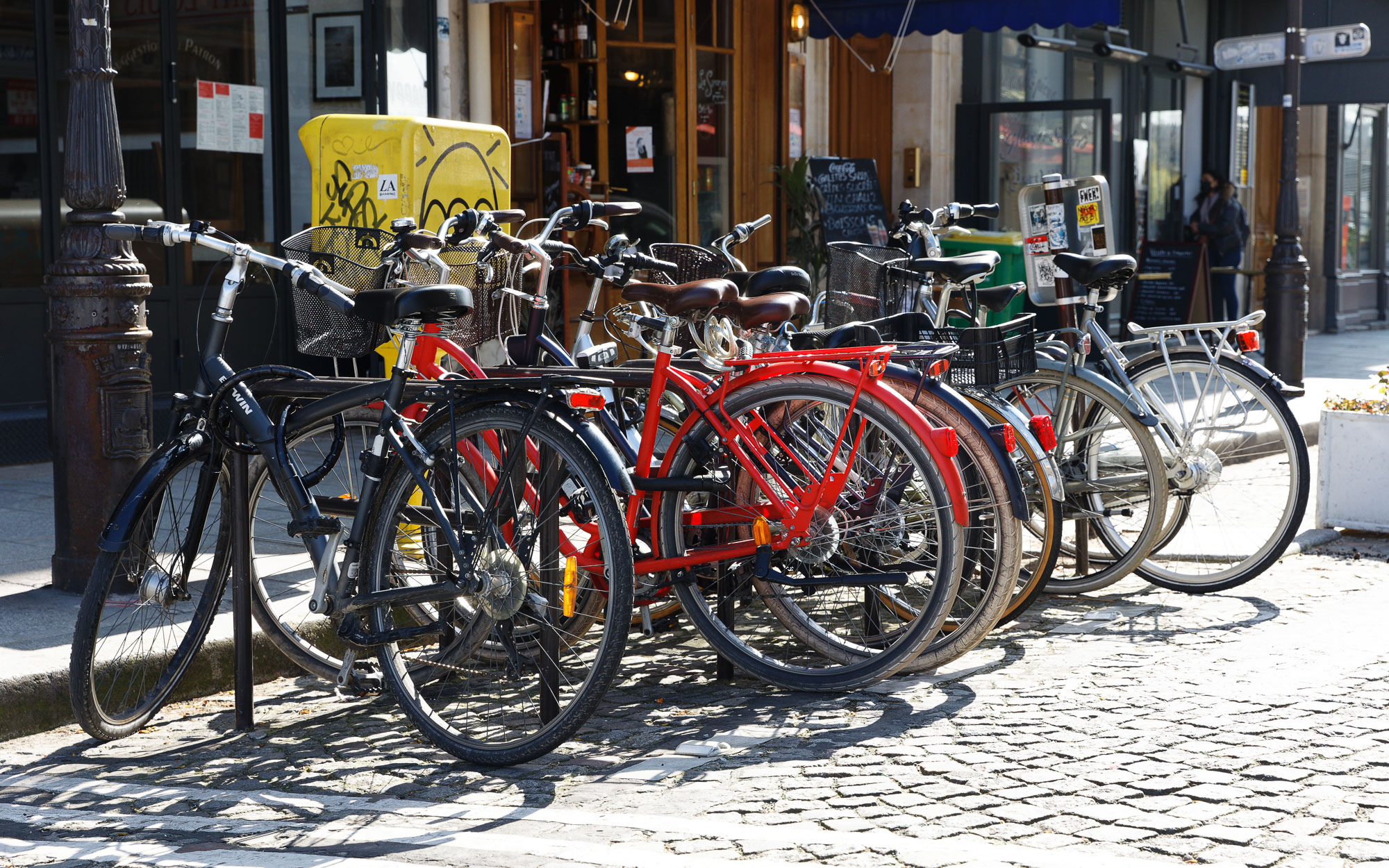
There are currently 60,000 parking spaces in Paris.
Crédit photo :
Henri Garat/Ville de Paris
In Paris, 6631 complaints of bicycle theft were recorded in 2020, up 7% on 2019.
81% of people who don't want to use a bike cite fear of theft as the main reason for not doing so. The availability of parking, particularly secure parking, is therefore one of the determining factors for using a bicycle as a means of transport.
What's the current offer?
-
60,000 bicycle racks and a trial of racks for cargo bikes.
-
Secure residential parking: 50 veloboxes representing 300 bicycle spaces, with a €75 annual subscription.
-
Two bicycle stations (198 places at Gare de Lyon, 375 places at Gare Montparnasse); three "Véligo" stations (60 places at Gare Montparnasse, 40 places at Gare de l'Est, 40 places at Gare Saint-Lazare).
-
Concession parking lots offer secure parking with 1,675 bicycle spaces, many featuring recharging points for electric bikes, and the number is continually increasing.
-
Municipal subsidies cover up to 50% of the costs for installing secure bicycle shelters for social housing and condominiums.
Target: more than 130,000 new places
-
30,000 new parking spaces in public spaces, including 1,000 spaces reserved for cargo bikes.
-
40,000 new secure, self-access parking spaces near stations or at intermodal points, under the aegis of Île-de-France Mobilités by 2030.
-
10,000 new secure parking spaces in public spaces, excluding intermodality points (veloboxes or other types of secure residential parking available by subscription).
-
50,000 new places in the private sector (social landlords and condominiums, businesses).
-
1,500 spaces on City of Paris sites (parking for City of Paris employees).
-
Secure parking requirements for all new construction/rehabilitation of private buildings, offices and establishments open to the public, and incentives if no major works are planned.
-
The creation of temporary parking facilities to meet the specific demands of major events.
Safer, more comfortable travel comfortable
To encourage cycling, we need to create a suitable environment. The priority is the safety of all users of public spaces, starting with the most vulnerable: pedestrians.
To contribute to the comfort and safety of all users, control operations by municipal police officers will be stepped up (respect for lanes by other users, respect for SAS Vélo signs, respect for pedestrian priority by cyclists, etc.).
The City of Paris will continue its efforts in these areas:
-
Awareness-raising and communication actions carried out with/by the municipal police and the Police prefecture, notably around the issue of blind spots, which are still not common knowledge.
-
Identification of theft and specific treatment to improve safety at these points.
-
Enforcement actions by city officials to ensure compliance with bike lanes and bike locks.
-
Safer junctions: further development of "Dutch-style" junctions and protective islands, continued marking of bicycle lanes.
-
Upgrading the equipment of heavy goods vehicles in the city and its delegated fleet.
Comfort and safety issues were also addressed. The following are planned:
-
the creation of a Code of the Street to facilitate cohabitation between all users, with reinforced control by the municipal police;
-
signposting to help cyclists find their way around, but also to position themselves correctly and make it easier to get around on major roads;
-
cleaning and clearing snow from cycle paths.
Supporting the cycling ecosystem
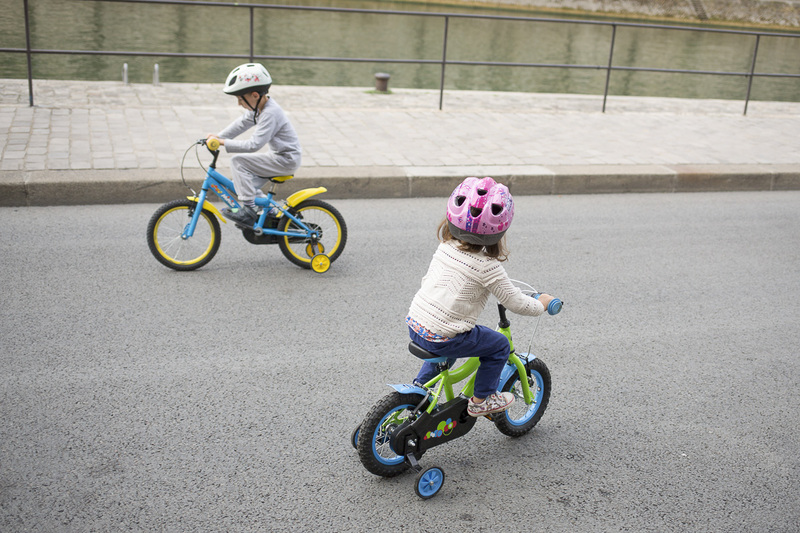
Paris wants to extend the "Savoir rouler à vélo" program.
Crédit photo :
Sophie Robichon / Ville de Paris
Training and maintenance
-
Paris wants to extend the "Savoir rouler à vélo" (how to ride a bike) program to all elementary schools in the city, by introducing a "Permis vélo" (bike permit). The aim is to ensure that all young Parisians know how to ride a bike by the time they reach secondary school.
-
Developing bike schools to facilitate adult learning.
-
Creation of one self-repair workshop per arrondissement.
"Eco-mobility" aids
A large number of mobility aids have been put in place since 2015 to support the changing mobility of Parisians.
Work is currently underway to reform the current aids to bring them more into line with the new expectations of individuals and professionals alike.
Support for associations
The APUR study on the evolution of businesses in Paris shows a 57% growth in businesses dedicated to bicycles (sales and repairs) between 2014 and 2017, and 29% between 2017 and 2020. There has also been exponential growth in the number of associations, of which there are almost thirty developing projects and offering services to users.
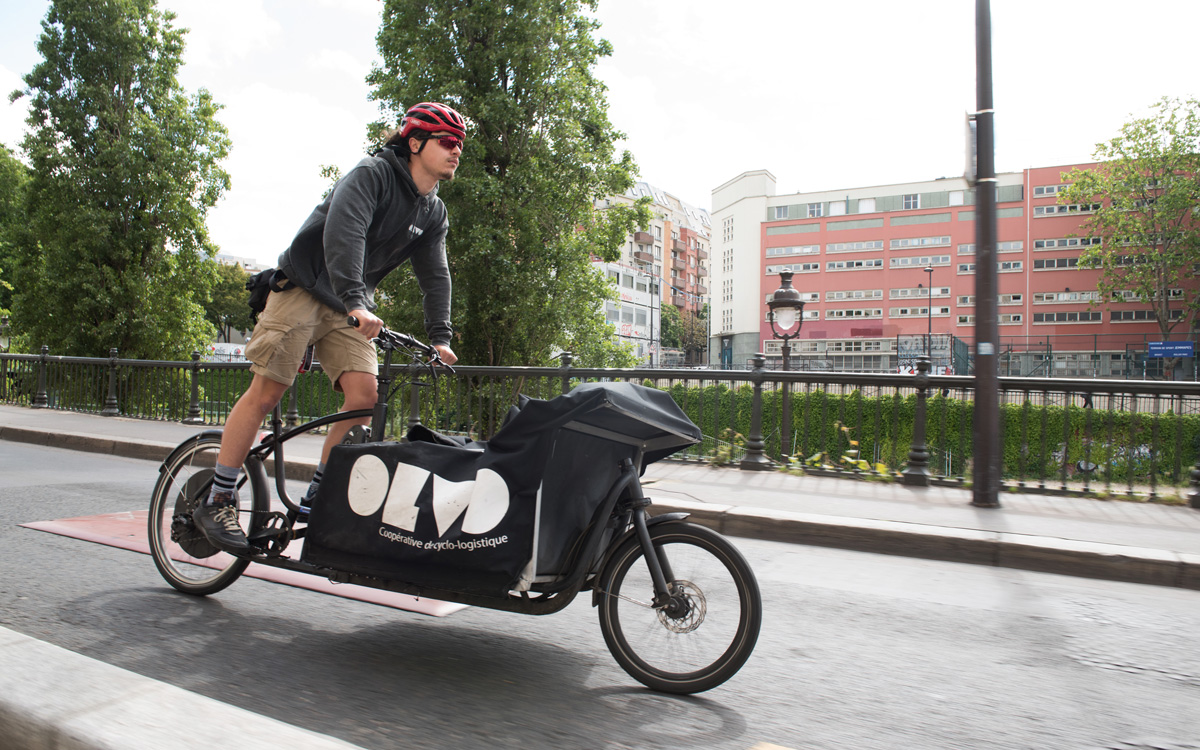
Cargo bike delivery driver
Crédit photo :
Emilie Chaix / Ville de Paris
The issue of cyclologistics has been integrated into the process of developing an urban logistics strategy, which has several focuses:
-
adapt cycle paths to take into account the dimensions of three-wheeled bicycles;
-
provide parking for these special bicycles, or even specific delivery areas for cargo bikes near major generators of two-wheeled traffic (large retailers such as Monoprix or Carrefour, for example);
-
improve working conditions and status for self-employed delivery drivers.
In particular, the city is working to find locations for route preparation close to final distribution points (the range of a bicycle is around 2 km), in the form of real estate sites (urban logistics areas) or public spaces (micro-hubs). These cyclologistics areas must be accessible to heavy goods vehicles.
Encourage cycling tourism
Cycle touring is enjoying spectacular growth at national level. Four major national or transnational cycle routes cross Paris, with a common crossing point on the square in front of Notre-Dame:
-
The Scandiberica (EV3) covers 5,122 km of track between Norway and Spain;
-
The London-Paris green avenue (V16) offers 470 km of cycle routes starting from the square in front of Notre-Dame ;
-
The La Seine à vélo cycle route (V33), linking Paris to Le Havre, was inaugurated in October 2020 and offers 420 km of dedicated facilities along the Seine ;
-
The Véloscénie (V40) links Paris to Mont-Saint-Michel over a 450 km route.
The Assises du tourisme durable organized by the City in 2021 highlighted the following needs:
-
Introduce regulations and accompanying measures to install bicycle storage facilities in tourist accommodation;
-
Improve signage on the four major cycle routes through Paris, and signage to tourist sites to direct visitors, particularly from intermodal points or entrances to the city;
-
Combine cycling with other forms of transport, in particular by allowing two-wheelers to be carried on board boats, coaches and trains;
-
For touring cyclists wishing to visit tourist sites, set up lockers to store panniers and luggage.
-
Pursue major cycling schemes, also on a metropolitan scale, to facilitate and encourage access by bike to major tourist sites in the Paris region (Château de Versailles, Saint-Denis Cathedral, Giverny, etc.).
Promoting the circular economy
-
Develop partnerships, such as the one between the city and Repar, to salvage wrecked bicycles and restore them and/or salvage parts. In 2020, despite the health situation, over 800 bicycles were reconditioned for resale at lower cost.
-
Create one self-repair workshop per arrondissement, i.e. 15 additional workshops.
Encouraging sports participation by taking advantage of the 2024 Games

Velodrama at La Cipale
Crédit photo :
Jean-Baptiste Gurliat/ Ville de Paris
Cycling as a sport encompasses a wide range of different disciplines: road, cyclo-cross, mountain bike, BMX race and freestyle, bike polo and indoor cycling. The practice of cycling on a daily basis is part of the "Sport Santé" objective, and improves public health by combating sedentary lifestyles, for all publics and especially senior citizens.
The Paris 2024 Games must be a highlight for cycling. Objective: 15% of all trips during the Games must be made by bike, and 20,000 event parking spaces will be required (not including the celebration sites). Cycling infrastructure and part of the secure parking facilities will be part of the Games' cycling legacy.
360,000 Vélib' subscribers
Vélib, the public bike-sharing service, currently has 1,406 stations, including 1,006 in Paris and 400 in the inner suburbs. There are currently 19,000 bicycles in circulation, 35% of which are electrically assisted.
The service has over 360,000 subscribers. In 2019, there were over 23.6 million Vélib' trips, including more than 9.2 million electric bikes. In 2020, an 11% increase in the number of rentals was recorded (with a record 215,000 journeys on one day in September).
We want to hear from you!
Was this information useful to you?
Please note: we cannot reply via this form (please do not include any personal information).


